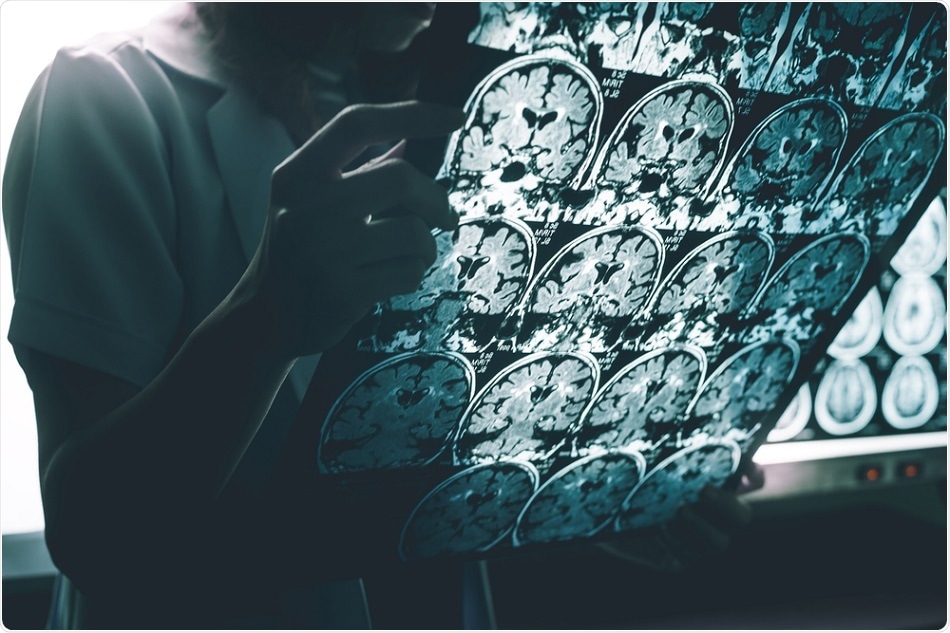In a new study, researchers describe a new technique they developed to find out exactly how Alzheimer’s disease (AD) affects nerve cells from the very beginning. The paper, published in the journal eNeuro, reports that the buildup of short chains of tau proteins, which are characteristic of AD and other neurodegenerative conditions, interferes with normal nerve impulse production and transmission in the nerve cell network. It also disturbs signal reception and disrupts synapses from forming new patterns of activity. This ultimately limits their capacity to better coordinate nerve transmission and facilitate physical and mental activity at higher levels.
 Atthapon Raksthaput | Shutterstock
Atthapon Raksthaput | Shutterstock
In AD, scientists have long found accumulations of an abnormal protein called amyloid-beta in plaques or flat deposits in the spaces around neuronal cells in the brain. They have also found a smaller protein called tau protein building up within the cells themselves. This protein is normally a beneficial one, which is extremely soluble. It stabilizes the cell structure by its effect on the microtubules with which it is associated. It also helps with the transport of various cell components inside the cell, again via microtubular transport. In AD, however, it changes its characteristics to become a dangerous substance.
How does the tau protein differ in AD?
The tau protein is actually a small molecule, as proteins go. However, it delinks from the microtubules when it is phosphorylated in the wrong manner. This then forms clusters, first by the joining of two of the basic protein units (a ‘dimer’), and then by chain formation by these dimers themselves to form a small chain of tau units or an ‘oligomer’. They also form neurofibrillary tangles, but it is in the oligomeric form that they actually cause neuronal damage. But how this occurs is still a mystery.
The solution
To answer the question of what is harmful about the tau oligomers, University of Warwick scientists found out first how they could artificially insert very low levels (at nanomole concentrations) of tau oligomers labeled with fluorescent tag molecules into single neurons in the brain. The exact structure of each molecule introduced was known. Since this ruled out the effect of tau oligomers outside the cell, in the extracellular space, this allowed them to trace how the concentration of such proteins affects the healthy cell’s properties, and also the tau movement through the cell, over a period of 45-50 minutes.
They also studied how these oligomers induced changes in the cell processes over time, using the information gained from electrical and physiological monitoring probes before and after injection of the tau oligomers. They looked at pairs of cells connected through synapses – the junctions between nerve cell processes where information transfer occurs from cell to cell – to help them understand if and how tau oligomers were involved in the dysfunction of this process.
The scientists found that tau monomers do not disturb normal cell processes. However, cell changes set in within as short a period as 30 minutes after the introduction of the tau oligomers into a healthy nerve cell. They prevented the formation of normal nerve impulses, altering the waveform. In other words, the electrical wave became shorter and slower.
A key finding is that tau oligomers are particularly enriched at synapses. Cells before the affected synapses showed weaker impulse formation, but after the synapse, the tau oligomers reduced the ability of the synapses to become stronger as they handled an increasing volume of activity. This is a fundamental part of neuronal plasticity, the ability of neurons to adapt and change their patterns of activity in response to long-term experience. They were interested to see this because this could help explain why tau accumulation disrupts memory-related processes.
The key finding is that introducing tau oligomers into single healthy neurons produces marked effects within a short time frame - around 30 minutes. By recording from pairs of connected cells we have been able to characterize the effects of tau on synaptic transmission at unparalleled levels of detail.”
Researcher Mark Wall
The importance
This study has brought out findings which could help develop medications to specifically tackle AD by preventing the formation of tau oligomers inside nerve cells.
Journal reference:
Introduction of tau oligomers into cortical neurons alters action potential dynamics and disrupts synaptic transmission and plasticity. Emily Hill, Thomas K. Karikari, Kevin G. Moffat, Magnus J. E. Richardson, and Mark J. Wall. Neuro 2019; 10.1523/ENEURO.0166-19.2019. https://doi.org/10.1523/ENEURO.0166-19.2019. https://www.eneuro.org/content/eneuro/early/2019/09/25/ENEURO.0166-19.2019.full.pdf